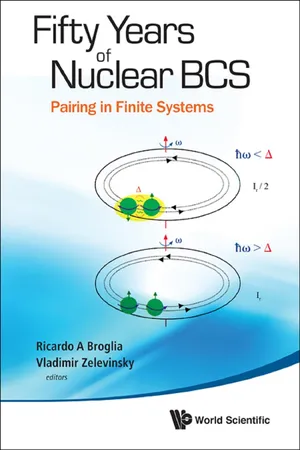Chapter 1
Pair Correlations in Nuclei: Copenhagen, 1958
S. T. Belyaev
The history of the ideas related to nuclear pairing and of the author's work in this direction is briefly reviewed.
The development of a theory of superconductivity in 1957, after forty six years of continuing efforts by many outstanding physicists, was a great scientific breakthrough.1 The history of this development is quite instructive.
At that time the superfluidity of quantum liquids, like 4He at low temperature, was already understood.2,3 The natural idea could be that superconductivity of metals is superfluidity of charged electron “liquid”. However, in contrast to atoms of 4He, electrons are fermions rather than bosons. Two fermions cannot share the same quantum state, and Fermi-condensate is impossible. Two electrons can form a Bose-particle if they are in a bound quantum state. But how can electrons get bound if they are negatively charged and repel each other? In metals the electron charge is neutralized by positively charged ions but for a bound state one needs some attraction.
The hint for the solution was given by the discovery of the isotopic effect in the dependence of the critical temperature for the onset of superconductivity on the atomic weight of ions in the crystal lattice.4 What can be a mechanism for the influence of the lattice on the interaction between electrons? Indeed, the waves (phonons) propagating through the lattice have frequencies depending on the atomic mass. One can imagine that one electron excites such a wave and another electron absorbs it inducing in this way the non-electrostatic interaction between the electrons. Calculations show that this exchange by phonons induces a weak electron–electron attraction. However, according to quantum mechanics, with weak attraction, a bound state is always possible only in one-dimensional or two-dimensional spaces, whereas in the three-dimensional case the attraction has to be sufficiently strong to form a bound state.
The Schrödinger equation for the relative motion of two particles may be written as
where ε(p) = p2/2m and U(r) > 0 are kinetic energy of relative motion and attractive interaction, respectively, while Δ is the binding energy we are looking for. This equation may be presented in the momentum representation as
and rewritten for the function
as
The right hand side part of this equation contains a small parameter, the strength of the interaction U. The critical value of this strength for the existence of a bound state corresponds to Δ → 0. So, the existence condition for very weak attraction may be fulfilled only if the integral is divergent for Δ = 0. For continuous spectra it happens in 1D- and 2D-cases but in the 3D-case the solution for a bound state emerges only if the interaction strength exceeds its critical value.
The key idea was suggested by the young American physicist Leon Cooper in a brief publication at the end of 1956.5 One can understand this idea using a simple electron model of a metal, where the entire positive charge of the crystal lattice is uniformly spread over the volume of the metal (the so-called “jelly model”) and completely compensates the electron charges. Inside each volume element of the metal, the electrons, being Fermi-particles, must have different magnitude and/or direction momenta, from the smallest ones up to a certain limiting quantity. The last occupied level marks the Fermi boundary, or Fermi surface; the whole occupied region of the momentum space is the Fermi zone. One can imagine a sphere whose radius determines the largest energy (or the momentum magnitude), while the various points on the surface of the sphere correspond to different directions of the momentum vector. Only the electrons near the Fermi surface can change their state of motion without requiring a lot of energy, since they can be lifted to free states above the Fermi surface after just a small energy gain. This means that the electrons near the Fermi surface effectively live not in three-dimensional but in two-dimensional space. Therefore the electrons can form bound states even for the weak attraction.
Such pairs of bound electrons, later named “Cooper pairs” after the author of the idea, form the ground state at the electron Fermi surface in superconductors. In order to excite this lowest energy state of the metal, one has to break a Cooper pair, which requires a finite amount energy, the so-called energy gap. This leads to the possibility for a not-too-strong electric current to flow without energy losses (superconductivity). For understanding the phenomenon of superconductivity, the Cooper pairing effect played a role of the last prompting. In half a year the paper by J. Bardeen, L. Cooper and R. Schrieffer1 appeared where the microscopic theory of superconductivity (BCS theory) was developed based on electron pairing.
The original version of the BCS theory was built on the variational wave function. N.N. Bogoliubov6 suggested a more general method of canonical transformations that could be promising for other problems as well. At that time I started thinking where and how this approach would apply. In order to explain the following development let me return to a few years earlier and talk briefly about my first steps in science.
My first acquaintance with real science can be dated to 1947 when, after five years of war experience, I was a second year student at the Physics Department of Moscow State University. After preliminary selection through a series of interviews, I decided to transfer to the newly opened Physical-Technical Department, where, along with usual lectures and recitations, the students had special days of practice at the “bases” corresponding to their majors. For our small (ten students) group specializing in “structure of matter”, the institution officially called “Laboratory No. 2 for Measuring Devices of the Academy of Sciences” (the Russian abbreviation LIPAN) and now generally known as Kurchatov Institute, served as such a “base”....




